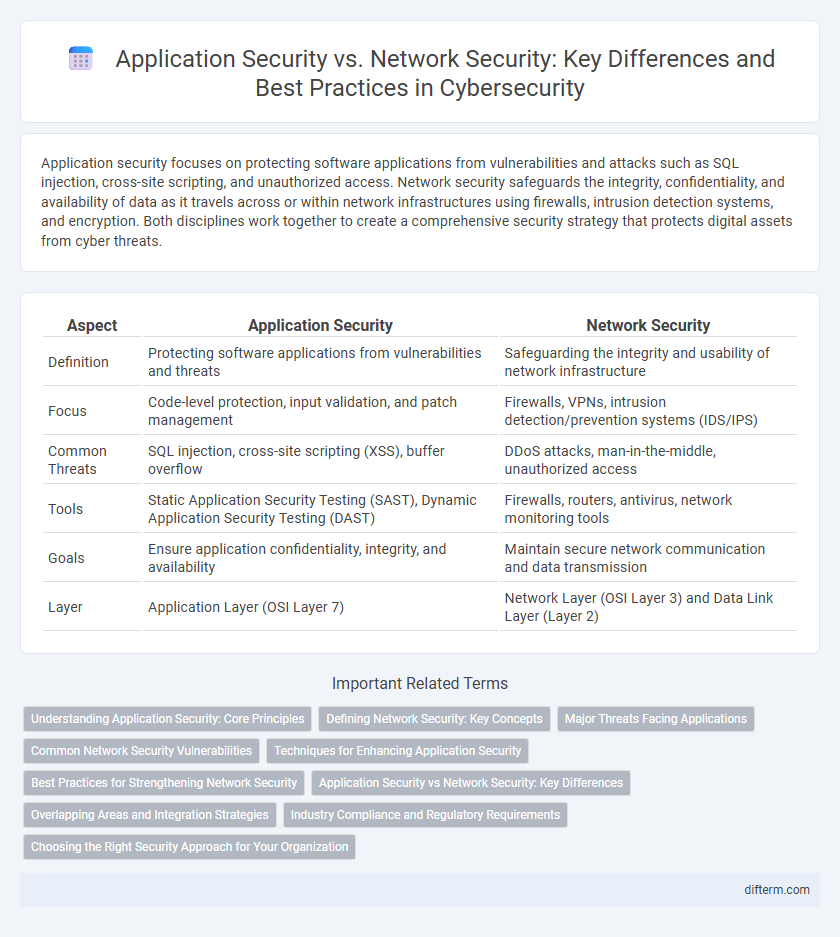Application security focuses on protecting software applications from vulnerabilities and attacks such as SQL injection, cross-site scripting, and unauthorized access. Network security safeguards the integrity, confidentiality, and availability of data as it travels across or within network infrastructures using firewalls, intrusion detection systems, and encryption. Both disciplines work together to create a comprehensive security strategy that protects digital assets from cyber threats.
Table of Comparison
| Aspect | Application Security | Network Security |
|---|---|---|
| Definition | Protecting software applications from vulnerabilities and threats | Safeguarding the integrity and usability of network infrastructure |
| Focus | Code-level protection, input validation, and patch management | Firewalls, VPNs, intrusion detection/prevention systems (IDS/IPS) |
| Common Threats | SQL injection, cross-site scripting (XSS), buffer overflow | DDoS attacks, man-in-the-middle, unauthorized access |
| Tools | Static Application Security Testing (SAST), Dynamic Application Security Testing (DAST) | Firewalls, routers, antivirus, network monitoring tools |
| Goals | Ensure application confidentiality, integrity, and availability | Maintain secure network communication and data transmission |
| Layer | Application Layer (OSI Layer 7) | Network Layer (OSI Layer 3) and Data Link Layer (Layer 2) |
Understanding Application Security: Core Principles
Application security emphasizes protecting software applications from vulnerabilities by implementing secure coding practices, regular security testing, and patch management. Key principles include authentication, authorization, encryption, and input validation to prevent threats like injection attacks and unauthorized access. Unlike network security, which safeguards data in transit, application security focuses on securing the application layer and ensuring data integrity within the software environment.
Defining Network Security: Key Concepts
Network security involves protecting the integrity, confidentiality, and availability of data as it travels across or is stored within network systems, using technologies such as firewalls, intrusion detection systems, and virtual private networks (VPNs). It focuses on safeguarding network infrastructure from unauthorized access, attacks, and breaches by implementing protocols like IPsec, SSL/TLS, and secure routing. Effective network security also includes continuous monitoring, vulnerability management, and access controls to prevent threats such as malware, DDoS attacks, and data interception.
Major Threats Facing Applications
Application security faces major threats such as injection attacks, cross-site scripting (XSS), and insecure authentication that specifically target software vulnerabilities. These threats exploit weaknesses in application code and user input validation to access sensitive data or disrupt services. Network security threats, while equally important, primarily involve external breaches like denial-of-service (DoS) attacks and unauthorized access to network infrastructure.
Common Network Security Vulnerabilities
Common network security vulnerabilities include unsecured Wi-Fi networks, weak firewall configurations, and outdated software protocols that expose systems to unauthorized access. Exploits such as Distributed Denial of Service (DDoS) attacks, man-in-the-middle attacks, and IP spoofing frequently target these weaknesses. Rigorous monitoring, regular patching, and robust encryption play crucial roles in mitigating risks associated with these network security flaws.
Techniques for Enhancing Application Security
Techniques for enhancing application security include implementing robust input validation to prevent injection attacks, employing secure coding practices like proper error handling and encryption, and integrating continuous security testing through automated vulnerability scanning and penetration testing. Utilizing multifactor authentication and role-based access control helps protect sensitive data by limiting unauthorized access within applications. Regularly updating and patching software components also mitigates risks associated with known vulnerabilities and strengthens overall application resilience.
Best Practices for Strengthening Network Security
Implementing robust firewall configurations and continuous network monitoring are essential best practices for strengthening network security, effectively reducing unauthorized access and potential breaches. Network segmentation and the use of intrusion detection and prevention systems (IDPS) enhance visibility and control over data flow, mitigating the risk of lateral movement within the network. Regularly updating network devices, applying security patches, and enforcing strong authentication protocols further fortify the network against emerging cyber threats.
Application Security vs Network Security: Key Differences
Application security involves protecting software applications from vulnerabilities and threats such as SQL injection, cross-site scripting, and authentication flaws, whereas network security focuses on safeguarding the integrity and availability of data as it travels across or within a network using firewalls, intrusion detection systems, and encryption protocols. The primary difference lies in scope: application security targets specific software-level vulnerabilities during development and runtime, while network security addresses broader infrastructure risks to prevent unauthorized access and attacks. Effective organizational security strategies integrate both disciplines, leveraging application security measures like code reviews and patch management alongside network security tools to ensure comprehensive defense.
Overlapping Areas and Integration Strategies
Application security and network security overlap significantly in areas such as intrusion detection, firewall implementation, and encryption protocols, ensuring comprehensive threat mitigation. Integrating these domains involves synchronized policy enforcement, unified threat intelligence sharing, and coordinated vulnerability assessments to strengthen overall security posture. Adopting a layered defense strategy enhances protection against complex cyber attacks by addressing both application-level and network-level vulnerabilities.
Industry Compliance and Regulatory Requirements
Application security and network security both play critical roles in ensuring industry compliance and meeting regulatory requirements such as GDPR, HIPAA, and PCI-DSS. Application security focuses specifically on securing software to prevent vulnerabilities that could lead to data breaches, aligning with standards for secure coding and vulnerability management. Network security addresses the protection of data in transit and infrastructure, enforcing access controls, encryption, and monitoring to comply with regulations governing data integrity and confidentiality.
Choosing the Right Security Approach for Your Organization
Selecting the appropriate security approach depends on your organization's specific vulnerabilities and operational needs. Application security protects software from threats by embedding safeguards during development, while network security defends data flow and connectivity across your infrastructure. Assessing risk exposure, compliance requirements, and resource allocation ensures the right balance between application-level controls and network perimeter defenses.
Application Security vs Network Security Infographic

 difterm.com
difterm.com